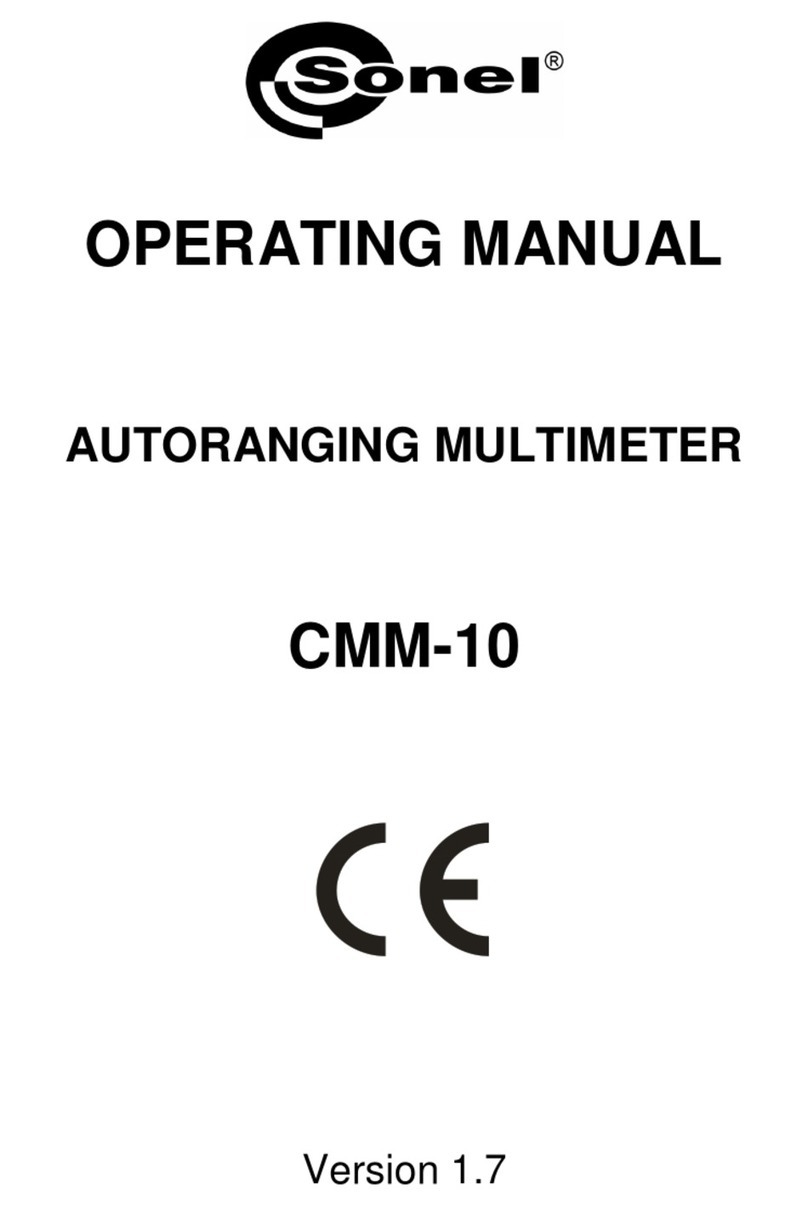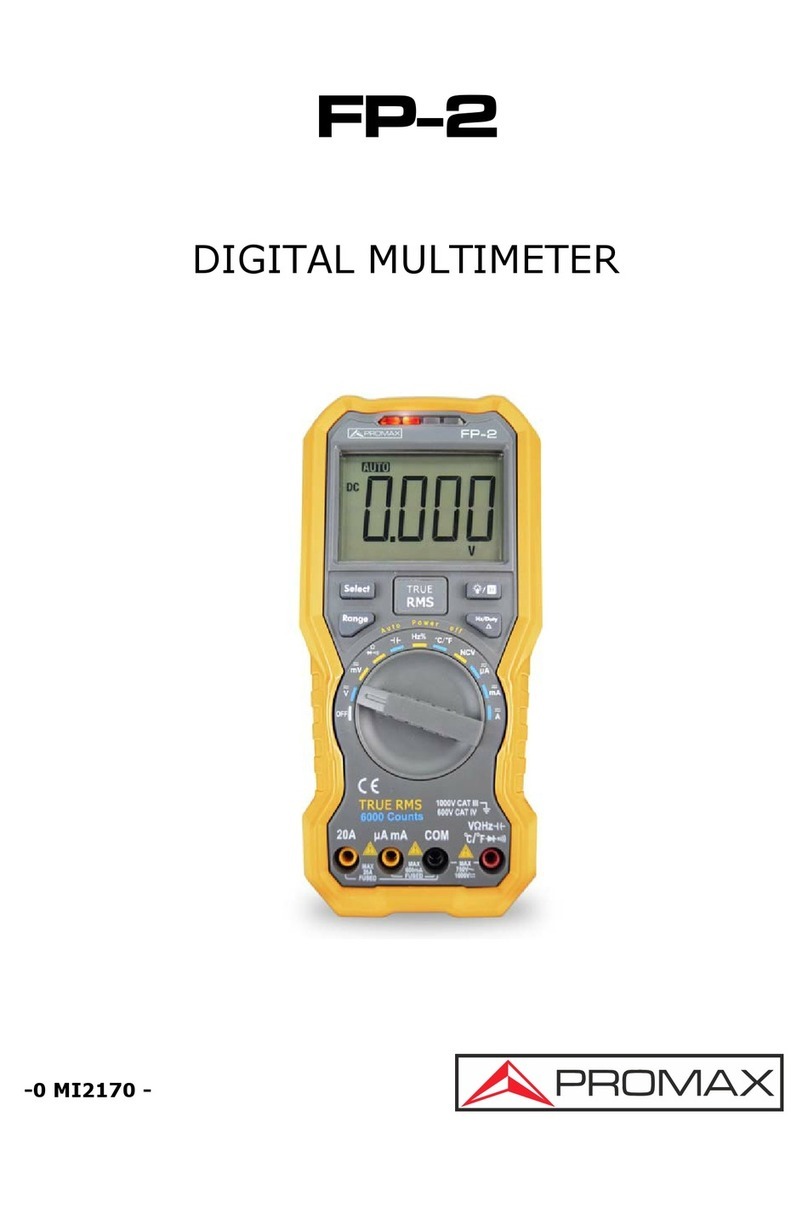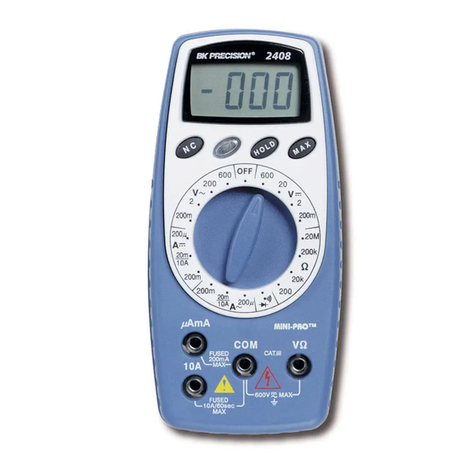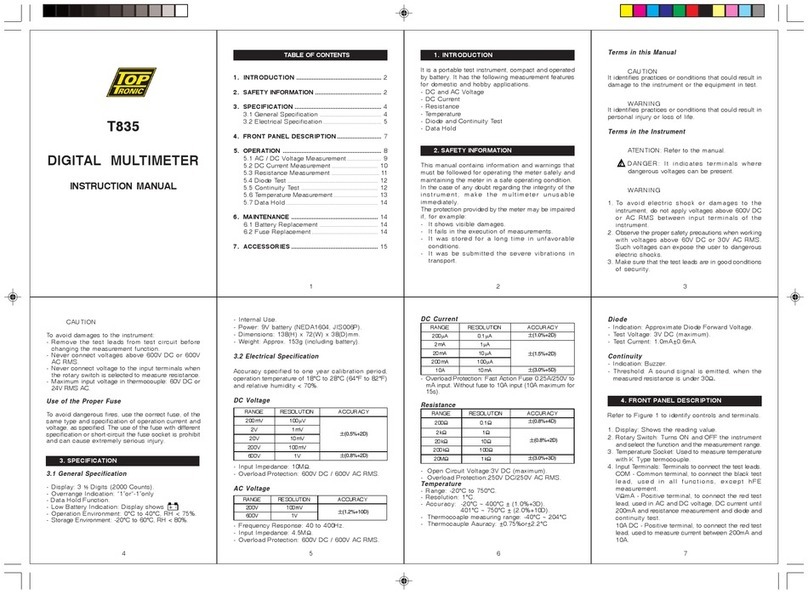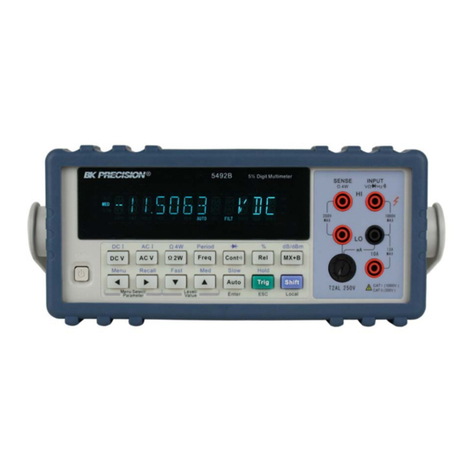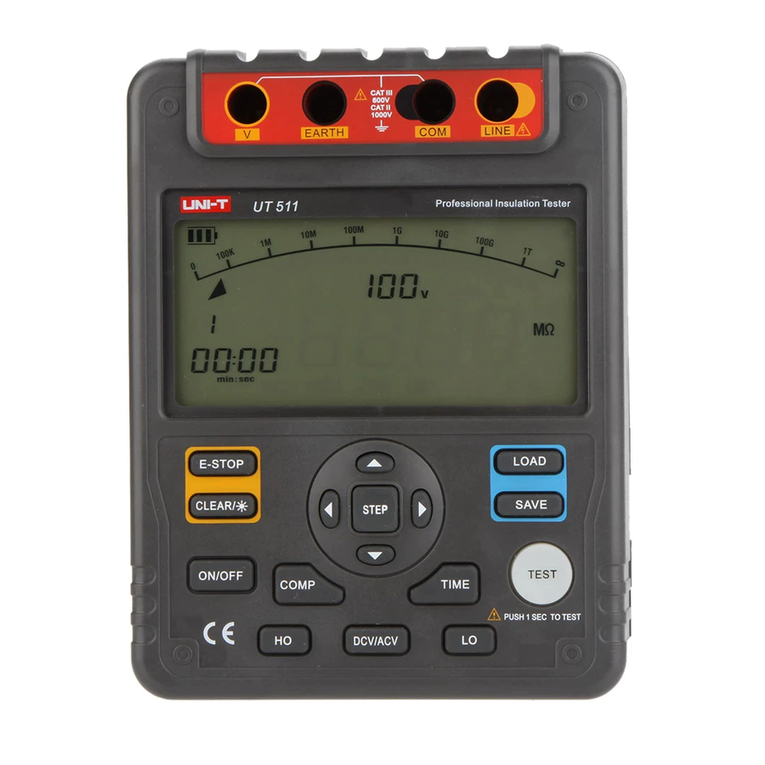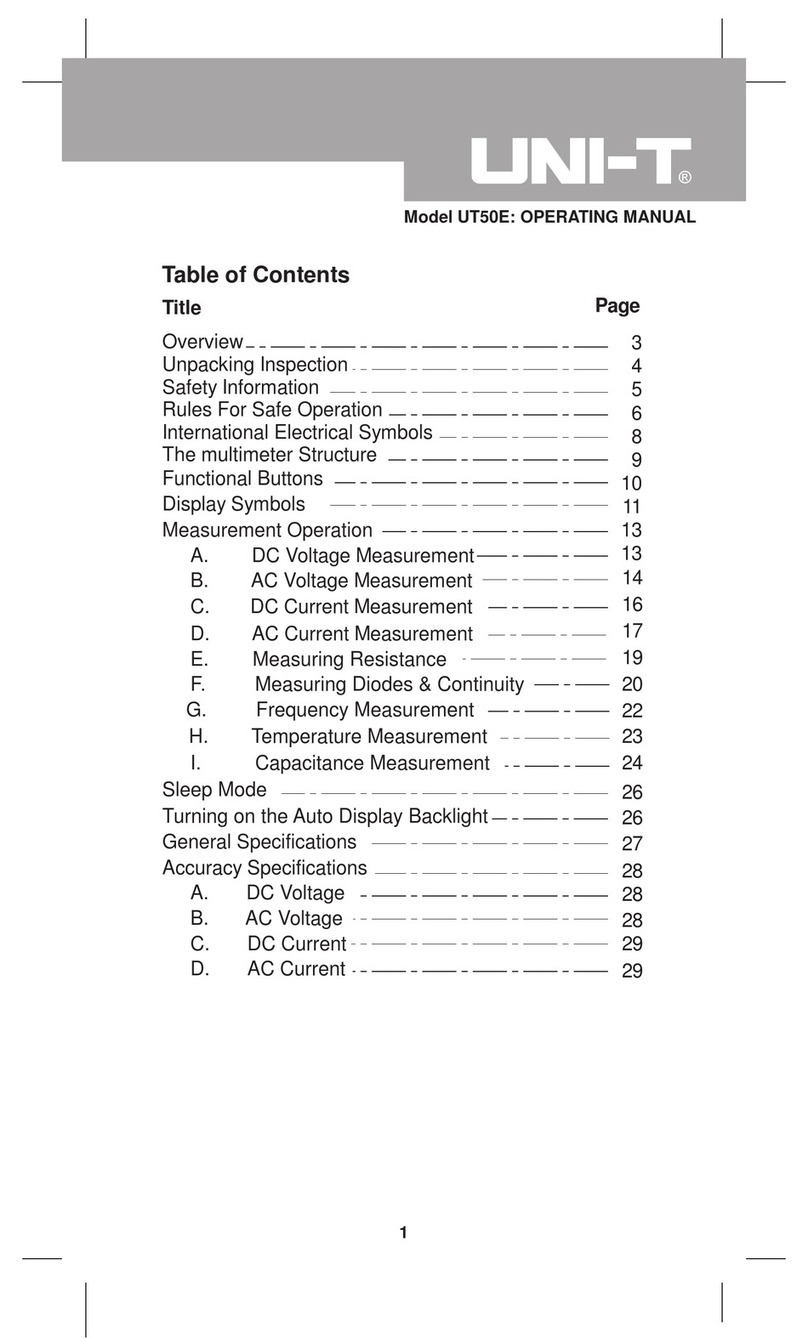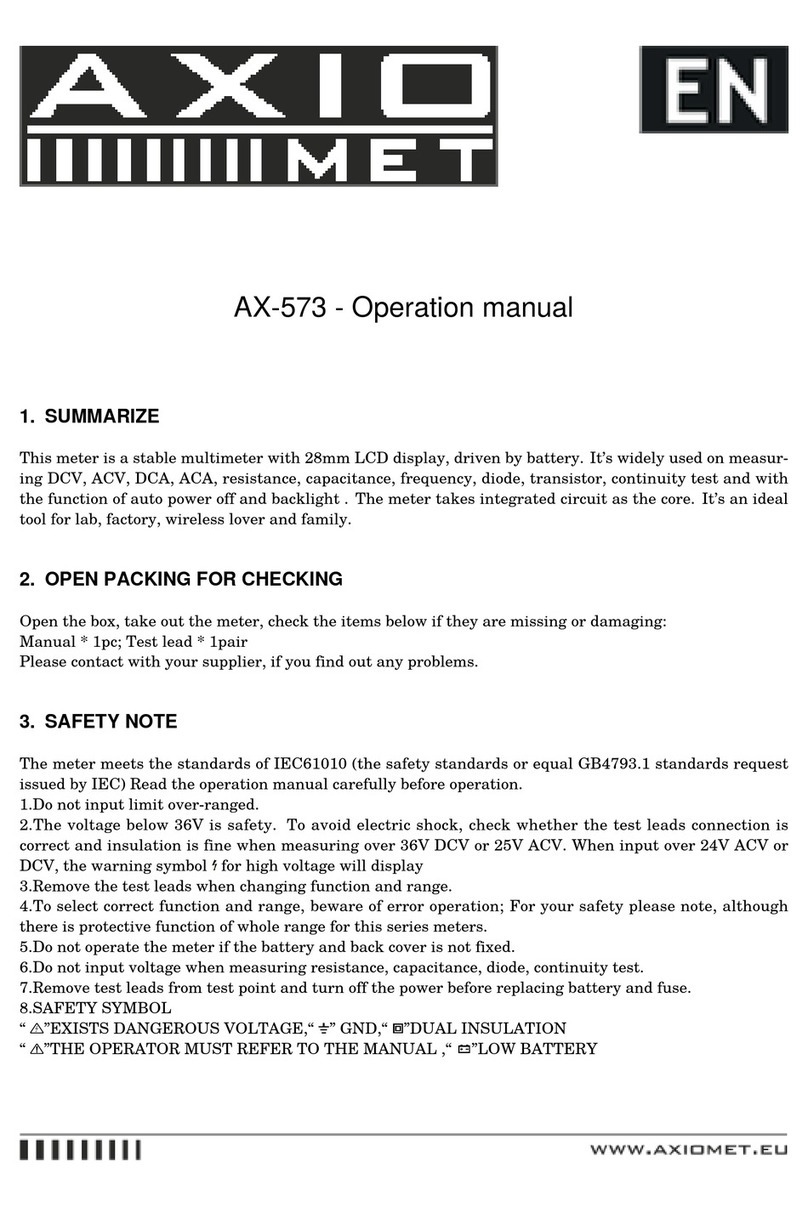Sonel MIC-2505 User manual





OPERATING MANUAL
INSULATION RESISTANCE METER
MIC-2505
SONEL SA
ul. Wokulskiego 11
58-100 Świdnica
Version 1.01 17.02.2012

OPERATING MANUAL MIC-2505 version 1.01
2
MIC-2505 meter is a modern, easy in use and safe measuring device. Please acquaint yourself with
the present manual in order to avoid measuring errors and prevent possible problems related to opera-
tion of the meter.

OPERATING MANUAL MIC-2505 version 1.01
3
CONTENTS
1SAFETY ....................................................................................................................4
2METER CONFIGURATION..................................................................................5
3MEASUREMENTS..................................................................................................7
3.1 DOUBLE-LEAD MEASUREMENT OF INSULATION RESISTANCE.....................................7
3.2 THREE-LEAD MEASUREMENT OF INSULATION RESISTANCE......................................10
3.3 VOLTAGE MEASUREMENT .....................................................................................11
4SOFTWARE UPDATES........................................................................................12
5METER POWER SUPPLY...................................................................................13
5.1 MONITORING OF THE POWER SUPPLY VOLTAGE .....................................................13
5.2 REPLACING RECHARGEABLE BATTERIES ................................................................13
5.3 CHARGING RECHARGEABLE BATTERIES .................................................................13
5.4 GENERAL PRINCIPLES REGARDING USING NIMH RECHARGEABLE BATTERIES..........14
6CLEANING AND MAINTENANCE ...................................................................15
7STORAGE ..............................................................................................................15
8DISMANTLING AND DISPOSAL ......................................................................15
9TECHNICAL SPECIFICATIONS .......................................................................16
9.1 BASIC DATA..........................................................................................................16
9.2 ADDITIONAL DATA ACCORDING TO IEC 61557-2 (RISO).........................................17
10 EQUIPMENT .........................................................................................................17
10.1 STANDARD EQUIPMENT ........................................................................................17
10.2 OPTIONAL ACCESSORIES.......................................................................................18
11 MANUFACTURER ...............................................................................................19

OPERATING MANUAL MIC-2505 version 1.01
4
1 Safety
MIC-2505 meter is designed for performing check tests of protection against electric shock
in mains systems. The meter is used for making measurements and providing results to determine
safety of electrical installations. Therefore, in order to provide conditions for correct operation and the
correctness of the obtained results, the following recommendations must be observed:
•Before you proceed to operate the meter, acquaint yourself thoroughly with the present manual
and observe the safety regulations and specifications determined by the producer.
•Any application that differs from those specified in the present manual may result in a damage to
the device and constitute a source of danger for the user.
•MIC-2505 meters must be operated only by appropriately qualified personnel with relevant certifi-
cates authorising the personnel to perform works on electric systems. Operating the meter by un-
authorised personnel may result in damage to the device and constitute a source of danger for the
user.
•During measurements of insulation resistance, dangerous voltage up to 2.5 kV occurs at the ends
of test leads of the meter.
•Before the measurement of insulation resistance you must be sure that tested object is discon-
nected from the power supply.
•During the measurement of insulation resistance do not disconnect test leads from the tested ob-
ject before the measurement is completed (see par. 3.1); otherwise the capacitance of the object
will not be discharged, creating the risk of electric shock.
•The instrument must not be used for the mains and equipment in rooms with special conditions,
such as fire or explosion hazard.
•It is unacceptable to operate the following:
⇒a damaged meter which is completely or partially out of order,
⇒a meter with damaged test leads insulation,
⇒a meter stored for an excessive period of time in disadvantageous conditions (e.g. excessive
humidity). If the meter has been transferred from a cool to a warm environment with a high
level of relative humidity, do not start measurements until the meter is warmed up to the am-
bient temperature (approximately 30 minutes).
•Displayed BATT symbol indicates insufficient voltage of power supply and the need to charge the
accumulator or replace batteries.
•Symbols ErrX, where Xis a number 1…9, indicate incorrect operation of the meter. If after restart-
ing the device this situation is repeated - it indicates that the meter is damaged.
•If after switching ON and displaying software version, message is displayed and the meter
switches OFF - send the meter for servicing. When is displayed every time after the meter is
switched ON, but the meter enters the measurement mode – update its software.
•Before measurement, choose a correct measurement function and make sure that test leads are
connected to respective measuring terminals.
•Do not operate a meter with an open or incorrectly closed battery (accumulator) compartment or
power it from other sources than those specified in the present manual.
•RISO inputs are electronically protected against overloads (caused by e.g. connecting the meter to
a live circuit) up to 600 V for 60 sec.
•Repairs may be carried out only by an authorised service point.
Note:
Due to continuous development of the meter’s software, the actual appearance of the display,
in case of some of the functions, may slightly differ from the display presented in this operat-
ing manual.

OPERATING MANUAL MIC-2505 version 1.01
5
2 Meter Configuration
Turn on the meter keeping SETUP
button pressed.
Use and buttons to set the auto-off time
or cancel auto-off function (horizontal lines).
Press SEL button to enter the setting of no-
minal network frequency.
Use and buttons to set the frequency
value.
Press SEL button to enter the setting the type
of absorption coefficients.

OPERATING MANUAL MIC-2505 version 1.01
6
Use and to set Ab1, Ab2 parameters (
) or PI, DAR ( ).
Press ENTER to display the measurement
screen, approving introduced changes or…
…press ESC to go to the measurement scre-
en without validating the changes.

OPERATING MANUAL MIC-2505 version 1.01
7
3 Measurements
3.1 Double-lead measurement of insulation resistance
WARNING:
The object tested must not be live.
Attention:
During measurement, especially of high resistances, make sure that test leads
do not touch each other and the probe (crocodile clips), because such a contact
may cause the flow of surface currents resulting in additional error in measu-
rement results.
Set the rotary switch of function
selection at one of RISO, choosing
measurement voltage. The meter
is in the voltage measurement
mode.
Times for calculating absorption coefficients are fixed at t1= 15s (30s for the coefficients Pi DAR), t2=
60s and t3= 600s.
Connect test leads according to the drawing.

OPERATING MANUAL MIC-2505 version 1.01
8
The meter is ready
for measurement.
Press and hold START push-button.
The measurement is performed continu-
ously until you release the button or the
pre-set time is reached.
In order to maintain (block) the measu-
rement press ENTER while holding
START button pressed - a triangle with
an exclamation mark will be displayed in-
dicating about automatic measurement,
now the buttons may be released. In or-
der to interrupt the measurement, press
START
or
ESC
.
View of the screen du-
ring measurement. The
triangle displayed on the
right side means that the
measurement was star-
ted with ENTER button.
After measuring is
completed, read the
result.
Use and to see individual components of the
result in the following order:
RISO→IL→Ab2→Ab1→Rt3→It3→Rt2→It2→Rt1→It1
→RISO.

OPERATING MANUAL MIC-2505 version 1.01
9
Note:
During measurements of insulation resistance, dangerous voltage up to 2.5 kV
occurs at the ends of test leads of MIC-2505 meter.
It is forbidden to disconnect test leads before the measurement is completed.
Failure to obey the above instruction will lead to high voltage electric shock and
make it impossible to discharge the tested object.
- Timer measuring the measurement time is started when UISO voltage is stabilized.
- Symbol LIMIT means operation with limited converter current. If this condition persists for 20 se-
conds the measurement is interrupted.
- If the timer reaches characteristic points (tx times), then for 1s instead UISO a symbol of this point is
displayed which is accompanied by a long beep.
- During the measurement LED is lit in yellow.
- After completion of measurement, the capacitance of the tested object is discharged by shorting
RISO+ and RISO- terminals with resistance of 100 kΩ.
- In case of power cables measure the insulation resistance between each conductor and other con-
ductors shorted and grounded (figure below).

OPERATING MANUAL MIC-2505 version 1.01
10
Additional information displayed by the meter
Test voltage is present on terminals of the meter.
NOISE!
Interference voltage higher than 25V but lower than 50V, is
present on the tested object. Measurement is possible but
may be burdened with additional uncertainty.
READY disappears,
LED lights red, two-
tone beep
Interference voltage higher than 50V is present on the te-
sted object. The measurement is blocked.
LIMIT I!
Activation of current limit. The symbol displayed is accom-
panied by a continuous beep.
Breakdown of the tested object insulation, the measure-
ment is interrupted. The message appears after displaying
LIMIT I! for 20s during the measurement, when voltage
previously reached the nominal value.
LED is
lit in red, two-tone
acoustic signal
During the measurement, AC voltage appeared or the ob-
ject cannot be discharged for 30 seconds. After 5 seconds
the meter returns to its default state - voltmeter.
3.2 Three-lead measurement of insulation resistance
In order to eliminate the influence of surface resistance in transformers, cables, etc. a three-lead
measurement is used. For example:
•at the measurement of inter-winding resistance of a transformer, Gsocket of the meter should
be connected to the transformer tank;
•when measuring insulation resistance between one of the cable conductors and the cable jac-
ket, the effect of surface resistances (important in difficult weather conditions) is eliminated by
connecting a piece of metal foil wounded around the insulation of the tested conductor with G
socket of the meter;

OPERATING MANUAL MIC-2505 version 1.01
11
The same shall apply when measuring the resistance between two conductors of the cable, at-
taching to Gterminal other conductors that do not take part in the measurement.
3.3 Voltage measurement
Set the rotary switch of function
selection at Uposition.
Connect the meter to a vol-
tage source.
Cable jacket
Metal shielding foil wounded around the insulation of
the conductor
Conductor

OPERATING MANUAL MIC-2505 version 1.01
12
Measurement is per-
formed in a continu-
ous manner.
Additional information displayed by the meter
, LED
is lit in red, two-
tone acoustic si-
gnal
Voltage is higher than acceptable.
Immediately disconnect the test leads.
4 Software updates
Turn on the meter, holding
ENTER and SETUP buttons de-
pressed.
The meter displays the following screen.
After connecting the meter to a PC using a
USB cable, follow the instructions of the software.

OPERATING MANUAL MIC-2505 version 1.01
13
5 Meter power supply
5.1 Monitoring of the power supply voltage
The charge level of rechargeable batteries is indicated by the symbol in the right upper corner of
the display on a current basis:
Batteries charged.
Batteries low. Only voltage measurement is available.
Batteries fully discharged,
all measurements are blocked.
The meter switches off automatical-
ly after 5 sec.
5.2 Replacing rechargeable batteries
MIC-2505 meter is powered from SONEL NiMH 9.6 V battery pack, including NiMH rechargeable
batteries.
Battery charger is installed inside the meter and cooperates only with the manufacturer’s battery
pack. The charger is powered by external power supply adapter. It can be also powered from the car
cigarette lighter socket, using an optional charger.
WARNING:
If the test leads are left in the terminals during replacement of the batteries, the-
re is a risk of electric shock with a dangerous voltage.
To replace the rechargeable batteries:
1. Disconnect the leads from the measuring circuit and turn off the meter,
2. Unscrew the 3 screws and remove the battery compartment (in the bottom of the enclosure).
3. Insert and bolt the battery compartment containing a new battery pack.
NOTE!
Do not power the meter from sources other than those listed in this manual.
5.3 Charging rechargeable batteries
Charging commences once the power supply has been connected to the meter regardless
of the fact whether the meter is on or off. Charging is indicated by changing status of battery charge.
The rechargeable batteries are charged in accordance with the algorithm of „quick charge” – this pro-
cess permits to reduce the duration of charging to approximately three hours. Completed charging

OPERATING MANUAL MIC-2505 version 1.01
14
process is indicated by full battery charge status and beep. In order to turn the device off, remove the
power supply plug of the charger.
Note:
- As a result of interferences in the network it is possible that the process of charging of accumulators
will finish too fast. When charging time is too short, turn off the meter and start charging again.
Additional information displayed by the meter
Signalling
Cause
Proceeding
Battery symbol appears as unfil-
led.
Temperature of the bat-
tery pack is too high!
Wait until the battery pack is cool. Start
charging process again.
The symbol of unfilled battery
flashes. Emergency
Try to start the charging process again.
If this does not help, it is possible that
battery pack is damaged - replace it.
The symbol of full battery flashes.
An attempt of recharge
fully charged battery
pack was detected.
5.4 General principles regarding using NiMH rechargeable batteries
- If you do not use the device for a prolonged period of time, then it is recommended to remove the re-
chargeable batteries and store them separately.
- Store the rechargeable batteries in a dry, cool and well ventilated place and protect them from direct
sunlight. The temperature of the environment in the case of prolonged storage should not exceed
30°C. If the rechargeable batteries are stored for a long time in a high temperature, then the occurring
chemical processes may reduce their lifetime.
- NiMH batteries withstand normally 500-1000 charging cycles These batteries reach their maximum
capacity after being formatted (2-3 charge/discharge cycles). The most important factor which influ-
ences the lifetime of rechargeable batteries is the level of their discharge. The deeper the discharge
level of the batteries, the shorter their lifetime.
- The memory effect is limited in case of NiMH batteries. These batteries may be charged at any point
with no serious consequences. However, it is recommended to discharge them completely every few
cycles.
During storage of NiMH batteries they are self-discharged at the rate of approximately 30% per month.
Keeping rechargeable batteries at high temperatures may accelerate this process even 100%. In order
to prevent excessive discharge of rechargeable batteries, after which it would be necessary to format
them, it is recommended to charge them from time to time (even if they are not used).
- Modern fast chargers detect both too low and too high a temperature of rechargeable batteries and
react to the situation adequately. Too low temperature should prevent starting the process of charging,
which might irreparably damage rechargeable batteries. An increase of the temperature of the rechar-
geable batteries is a signal to stop charging and is a typical phenomenon. However charging at a high
ambient temperature apart from reducing batteries' lifetime causes an accelerated increase of their
temperature and the result is that the batteries are not charged to their full capacity.
- Please note that when the batteries are charged with a fast-charger they are charged only to approx.
80% of their capacity - better results can be achieved by continuing charging: the charger enters
trickle-charging mode and during the next few hours batteries are charged to their full capacity.

OPERATING MANUAL MIC-2505 version 1.01
15
- Do not charge or use rechargeable batteries in extreme temperatures. Extreme temperatures reduce
the lifetime of batteries and rechargeable batteries . Avoid placing devices powered by rechargeable
batteries in very hot environments. The nominal working temperature must be absolutely observed.
6 Cleaning and maintenance
NOTE!
Apply solely the maintenance methods specified by the manufacturer in this ma-
nual.
The casing of the meter may be cleaned with a soft, damp cloth using all-purpose detergents. Do
not use any solvents or cleaning agents which might scratch the casing (powders, pastes, etc.).
The electronic system of the meter does not require maintenance.
7 Storage
In the case of storage of the device, the following recommendations must be observed:
•Disconnect all the test leads from the meter.
•Clean the meter and all its accessories thoroughly.
•In the case the meter is to be stored for a prolonged period of time, batteries/rechargeable batte-
ries must be removed from the device.
•In order to prevent a total discharge of the rechargeable batteries in the case of a prolonged sto-
rage, charge them from time to time.
8 Dismantling and Disposal
Used electrical and electronic equipment should be collected selectively, i.e. it must not be placed
with another kinds of waste.
Used electronic equipment should be sent to a collection point in accordance with the Used Elec-
trical and Electronic Equipment Act.
Before the equipment is sent to a collection point, do not dismantle any elements.
Observe the local regulations concerning disposal of packages and used batteries/rechargeable
batteries.

OPERATING MANUAL MIC-2505 version 1.01
16
9 Technical specifications
9.1 Basic data
⇒Abbreviation "m.v" used in the specification of measurement uncertainty means a standard me-
asured value
AC / DC voltage measurement
Display range
Resolution
Basic uncertainty
0…600V
1 V
±
(3% m.v. + 2 digits)
•Frequency range: 45...65Hz
Measurement of insulation resistance
Measuring range according to IEC 61557-2: RISOmin = UISOnom/IISOnom …2,000TΩ(IISOnom = 1mA)
Double-lead measurement
Display range
Resolution
Basic uncertainty
0.0 ... 999.9 kΩ0.1 k Ω
±(3 % m.v. + 20 digits)
1.000 ... 9.999 M
Ω
0.001M
Ω
10.00...99.99M
Ω
0.01 M
Ω
100.0 ... 999.9 M
Ω
0.1 M
Ω
1.000 ... 9.999 GΩ0.001 GΩ
10.00 ... 99.99 G
Ω
0.01 G
Ω
100.0...999.9GΩ
0.1 GΩ
1.000...2.000TΩ0.001TΩ
Approximate maximum values of the measured resistance, depending on the test voltage, are
presented in the table below. For other voltages the range limits may be read from the chart below.
Voltage
Test range
500V
500G
Ω
1000V
1,00TΩ
2500V
2,00TΩ
⇒Note: For insulation resistance below RISOmin there is no accuracy specified because the meter
works with the adjustable current limit in accordance with the following formula
ISOnom
nomISO
ISO I
U
R=
min
where:
RISOmin - minimum insulation resistance measured without limiting the converter current
UISOnom - nominal test voltage
IISOnom - nominal inverter current (1mA)
a) type of insulation.......................................................double, EN 61010-1 and IEC 61557 compliant
Other technical specifications
b) measurement category .............................................. IV 600V (III 1000V) according to EN 61010-1
c) degree of housing protection acc. to EN 60529.........................................................................IP54
d) power supply of the meter...................................................... SONEL L-1 battery pack 9.6 V, NiMH
e) dimensions ........................................................................................................ 260 x 190 x 60 mm
Table of contents
Other Sonel Multimeter manuals
Popular Multimeter manuals by other brands
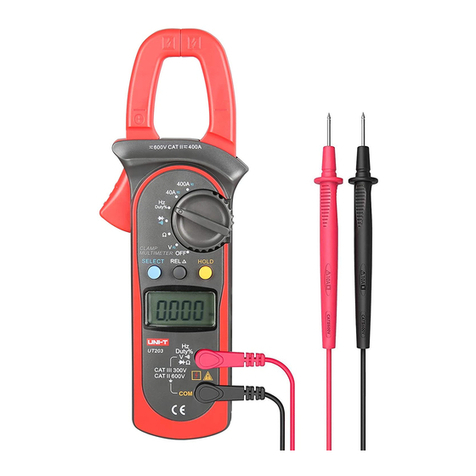
Unit
Unit UT203 operating manual
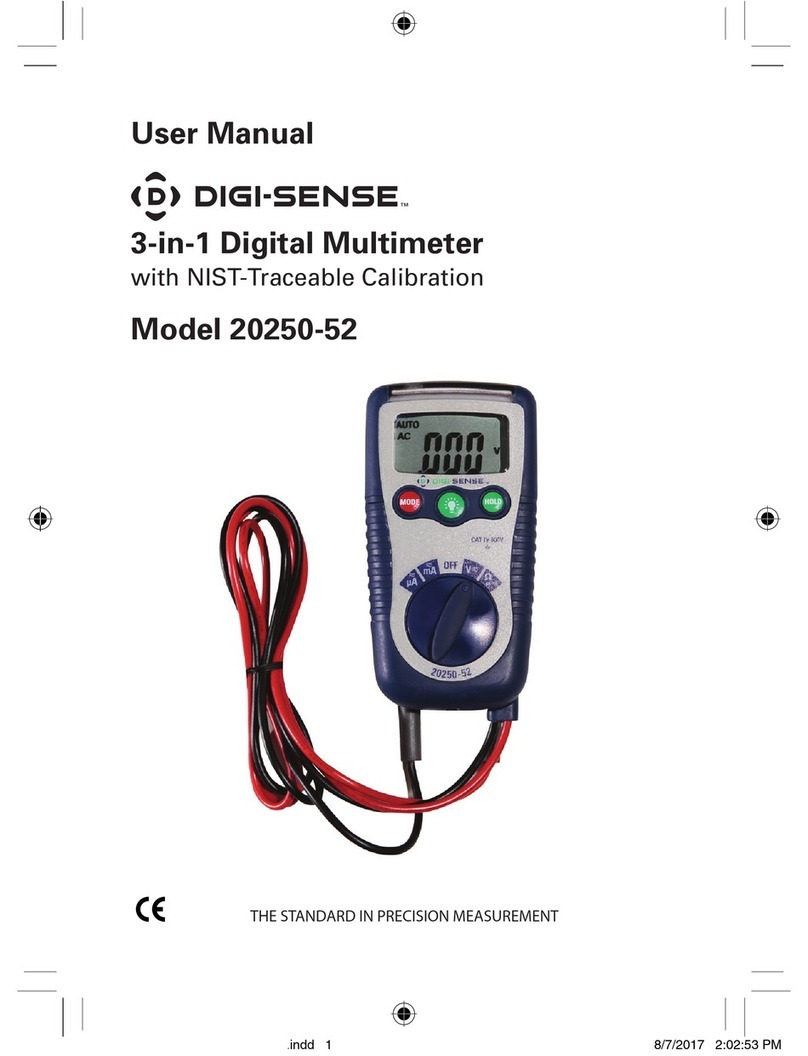
Digi-Sense
Digi-Sense 20250-52 user manual
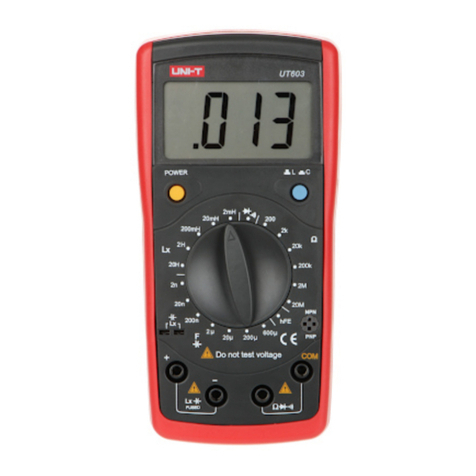
Unit
Unit UT603 user manual
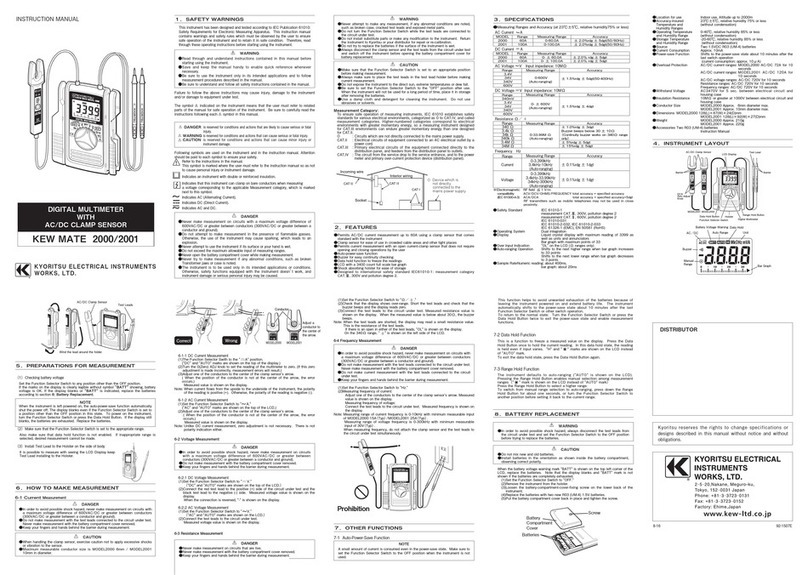
Kyoritsu Electrical Instruments Works, Ltd.
Kyoritsu Electrical Instruments Works, Ltd. KEW MATE 2001 instruction manual
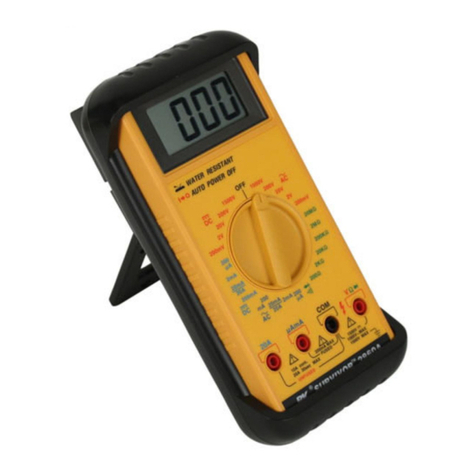
B+K precision
B+K precision 2860A instruction manual
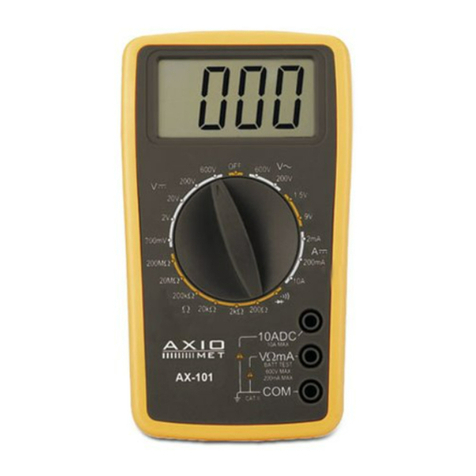
Axio MET
Axio MET AX-101 Operation manual


